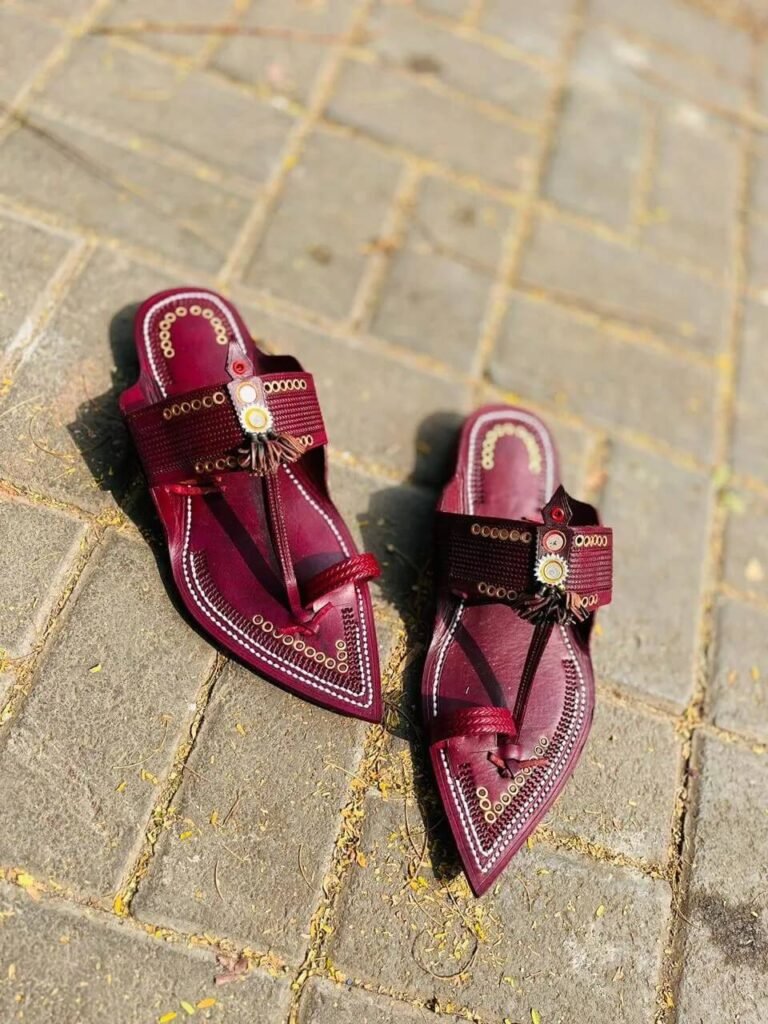Introduction
Kolhapur, a city steeped in tradition and cultural pride, is globally recognized for its iconic contribution to Indian craftsmanship — the Kolhapuri chappal. This humble leather slipper is more than just footwear; it is a symbol of identity, heritage, and sustainable artistry. Worn for centuries and now worn on international runways, Kolhapuri chappals represent a perfect blend of tradition and modern relevance.

In this blog, we explore the history, craftsmanship, economic importance, and the ongoing global appeal of Kolhapuri chappals.
The Historical Roots of Kolhapuri Chappals
Kolhapuri chappals trace their roots back to the 12th century during the reign of King Bijjala and his minister Basavanna, a social reformer. It is believed that the craft originated in the villages surrounding Kolhapur where local cobblers and artisans created these sturdy and stylish leather slippers for rural use. Originally called “Kapashi” chappals, they were known for their simplicity, durability, and unique design without nails or stitching.
By the 18th and 19th centuries, the chappals began to evolve into the intricate, hand-tooled designs we see today, often made by the Chambhar community, traditionally associated with leatherwork.
What Makes a Kolhapuri Chappal Unique?
Kolhapuri chappals are not just any pair of slippers — their uniqueness lies in the blend of material, method, and meticulous design. Here’s what sets them apart:
- Handmade Craftsmanship: Each pair is handcrafted without any machinery.
- Natural Leather: Made from locally sourced buffalo or cowhide leather.
- Vegetable Tanning: Dyed using natural ingredients like tree bark, making them eco-friendly.
- Durability: Extremely tough and can last years.
- Designs: Intricate embossing, braiding, and cutwork that reflect traditional motifs.
- No Nails or Chemicals: Traditional techniques avoid industrial elements, keeping the product authentic and sustainable.
The Cultural Significance
In Kolhapur and surrounding parts of Maharashtra and Karnataka, these chappals are more than footwear — they are part of daily attire, festivals, and wedding customs. Many consider them auspicious and include them in bridal trousseaus or religious offerings.
Additionally, they have long been worn by saints, farmers, and even royalty. The blend of comfort, utility, and elegance makes them integral to rural and urban life alike.
From Local Markets to Global Runways
In the early 20th century, British officers and Indian royals started to take notice of the craftsmanship behind Kolhapuri chappals. Soon, these leather shoes found their way to elite wardrobes.
Fast forward to the 21st century, and Kolhapuri chappals are now featured in:
- Fashion Weeks across India and abroad.
- Designer Collaborations with ethnic and boho brands.
- E-commerce portals selling them globally with modern twists — pastel colors, wedges, cushioned soles, and even vegan leather.
They have made their mark as a slow fashion product — handcrafted, local, durable, and stylish — in an age dominated by fast fashion.
Economic Impact and Employment
The Kolhapuri chappal industry is a vital economic lifeline for thousands of artisans, especially in rural Maharashtra.
- Employment: Over 10,000 families are engaged in this craft directly or indirectly.
- Women Empowerment: Many workshops include women artisans who handle stitching, design, and finishing work from home.
- Exports: These chappals are now exported to the US, UK, UAE, and other countries.
- GI Tag: In 2019, Kolhapuri chappals received the Geographical Indication (GI) tag, which protects their regional identity and offers legal protection against imitation.
Challenges Faced by the Industry
Despite the charm and economic importance, the Kolhapuri chappal industry faces several hurdles:
- Cheap Imitations: Mass-produced lookalikes from other regions dilute brand authenticity.
- Modern Footwear Trends: Sneakers and branded fashion shoes dominate urban markets.
- Raw Material Cost: Leather procurement and processing are becoming expensive.
- Lack of Government Support: Artisans often lack direct access to global markets and subsidies.
- Skill Attrition: Younger generations are less inclined to continue the family craft due to lower income and lack of glamor.
Revival Efforts and Innovations
However, all hope is not lost. Many organizations, NGOs, and government bodies are working to revive and sustain this legacy:
- Online Platforms like Amazon Karigar, Flipkart Samarth, and handmade-focused sites are onboarding rural artisans.
- Design Interventions by NIFT (National Institute of Fashion Technology) and independent designers are helping modernize the chappals.
- Skill Development Programs are being run to train the next generation.
- Fashion Bloggers and Influencers are promoting ethnic and sustainable fashion through Kolhapuri chappals.
How to Spot a Genuine Kolhapuri Chappal
Due to mass-produced knockoffs, it’s essential to identify authentic Kolhapuris. Here’s how:
- Made in Maharashtra: Especially districts like Kolhapur, Sangli, and Solapur.
- Thick Sole: Usually one piece of leather shaped and molded by hand.
- Hand Stitched: You’ll notice the fine threads and no machine marks.
- Unique Smell: Due to natural vegetable tanning.
- Artisan Tags: Some cooperatives now include tags or QR codes for verification.
Why Kolhapuri Chappals Are Still Relevant Today
- Eco-Friendly: No synthetic materials or chemicals.
- Handmade: Supports local economies and craftspeople.
- Fashion Versatility: Goes with traditional wear and Indo-Western outfits.
- Long Life: You buy once and use for years — an antidote to fast fashion.
Conclusion
Kolhapuri chappals are more than footwear — they are a legacy. They carry within them stories of tradition, community resilience, eco-consciousness, and timeless fashion. As consumers, when we choose a pair of Kolhapuri chappals, we are choosing to walk a path of culture, sustainability, and support for local artisans.
Whether you’re a fashion lover, a culture enthusiast, or just someone looking for comfortable footwear — Kolhapuri chappals are a perfect fit.


